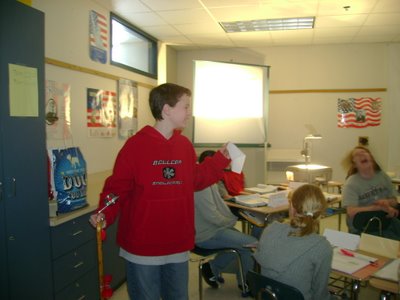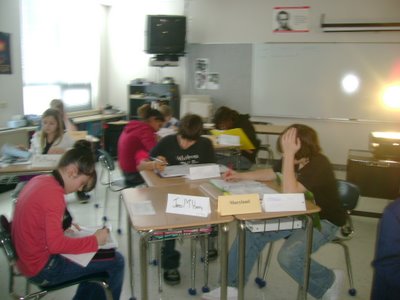We are now beginning our study of the organization of the Constitution. the first thing we will discuss is the Preamble. The Preamble is the introduction to the Constitution, it states six specific goals of the U.S. government. Here is what it says:
We the People of the United States, in order to form a more perfect Union, establish Justice, insure domestic Tranquility, provide for the common defense, promote the general Welfare, and secure the Blessings of Liberty, to ourselves and our Posterity, do ordain and establish this Constitution for the United States of America.
Here is a fun video about the Preamble from the Andy Griffith show (if you've never heard of the show, ask your parents or grandparents):
Monday, January 29, 2007
Constitutional Convention - The Final Day
As our Constitutional Convention came to a close, delegates showed their support for the document by signing it. Some delegates, however, chose not to sign it and had to explain their reasons. Some delegates did not sign the Consitution because they felt it gave too much power to the federal government, and they feared the return of a monarchy. Others felt that the document talked too much of the powers of government, and did not have anything in it to protect the rights of the people.
After the Constitution was written, it had to be sent to the states for ratification (official approval).


After the Constitution was written, it had to be sent to the states for ratification (official approval).



Tuesday, January 23, 2007
Constitutional Convention - Day 2
On the second day of the Convention, classes finished up debating the issue of how representation in the national legislature (congress) would be determined. A 2/3 majority was needed in our convention for a motion to pass. Some classes were able to agree and voted to adopt a compromise, others were not able to gather enough votes to pass any resolution.
We also began debating Issue 2 which dealt with slaves. Soouthern states wanted slaves to count as part of their poplulation so that they could have more representatives in Congress. Northern states did not agree with the South, and instead felt that the southern states should have to pay taxes on their slaves.
We will conclude the debate on this issue on Day 3. Hopefully some of the classes will be able to reach a resolution on this issue.
Delegate Alexander Hamilton of New York:

Delegate George Read of Delaware address the convention about the role of slaves in determining a states representation in Congress:


We also began debating Issue 2 which dealt with slaves. Soouthern states wanted slaves to count as part of their poplulation so that they could have more representatives in Congress. Northern states did not agree with the South, and instead felt that the southern states should have to pay taxes on their slaves.
We will conclude the debate on this issue on Day 3. Hopefully some of the classes will be able to reach a resolution on this issue.
Delegate Alexander Hamilton of New York:

Delegate George Read of Delaware address the convention about the role of slaves in determining a states representation in Congress:

Delegates request permission to speak from the President of the Convention, General George Washington:

Benjamin Franklin of Pennsylvania uses a metaphor to make his point:
Delegates read about the issues before they debate:
Constitutional Convention - Day 1
On Monday we began a mock Constitutional Convention in class in order to better understand the issues that faced the delegates from each state in creating the actual Constitution. Each student has been assigned a delegate, and must act and vote the way that that person did, while I preside over the Convention as George Washington.
To open up the convention, we first discussed the rules of order and parliamentary procedure. We then took a “vow of secrecy”, to remind us that the original delegates were not allowed to speak about the convention to the public.
The first issue we discussed was about how the people would be represented in our new government. Delegates from the larger states wanted a legislature (congress) with representation based on the population of each state. Other delegates felt that all of the states should be represented equally.
None of the classes were able to reach the majority vote needed to adopt either idea. Some of them, however, were able to reach a compromise solution.
Delegates confer with each other before a vote:

To open up the convention, we first discussed the rules of order and parliamentary procedure. We then took a “vow of secrecy”, to remind us that the original delegates were not allowed to speak about the convention to the public.
The first issue we discussed was about how the people would be represented in our new government. Delegates from the larger states wanted a legislature (congress) with representation based on the population of each state. Other delegates felt that all of the states should be represented equally.
None of the classes were able to reach the majority vote needed to adopt either idea. Some of them, however, were able to reach a compromise solution.
Delegates confer with each other before a vote:


Subscribe to:
Posts (Atom)